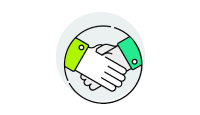Tech for All: Creating Fair Workplaces
+400 Points
Technology has become an essential tool in changing how we work today. It's helping to break down barriers and create opportunities for all to succeed. Yet, many workplaces are not taking advantage of this capability of technology. Companies can use tech tools to help create a workplace where everyone can shine. Technology can help with hiring practices, how employees learn and grow, and how programs and products focus on success for all.
Ready to level up the workplace access to opportunities with tech? Let’s do this! You could win big $$$. In this Challenge, you’ll pitch an idea to Lenovo for a business, product, or campaign that leverages technology and addresses the question:
How can technology be used to provide access to opportunities in the workplace?
The Challenge was Sept 23-Nov 1, 2024.


Skills you'll develop
- Problem Solving
- Communication
- Social Awareness
Explore the Issue
Congratulations on taking the first step to solve this Challenge -- becoming an expert on the topic! Pick and choose from all of the resources in this section to learn about the topic. Watch the video to learn more about this phase. Note that NAF has recommended all of the videos and other resources in the Challenge.
⏱️Time: 2- 4 Hours (Week 1 of the Challenge)
✏️Use the optional KNOtebook to record notes and questions
💼Mentor: Ask a mentor questions about the topic
🎯Future-Ready Skills: Social Awareness, Initiative and Self-Direction
Build Background Knowledge
Have you ever been left out of a game or felt like your ideas weren't heard? That's not fair, right? Well, sometimes that happens in the workplace too. But it's not just about being fair. It's about making sure everyone has the same chances to succeed and feels like they belong. This is where technology comes in. Cool new tools can help companies make their workplaces welcoming and fair for everyone, no matter their background or abilities. In this Challenge, you'll get to explore how we can use tech to create workplaces where everyone feels valued and can achieve their dreams.
Belonging in the Workplace
In today's world, companies must be fair to everyone and make sure all workers feel included and valued. This helps businesses do better, come up with cooler ideas, and make their employees happier. Flip the cards to strategies in the workplace.

Shared Success, Better Products for All!
Shared Success, Better Products for All!
When companies embrace practices that focus on belonging, they open the door to fresh perspectives and innovative ideas. This leads to products and services that resonate with a wider audience, driving business growth and success. A focus on teams that are welcoming to everyone is 35% more likely to outperfor...
Fairness = Higher Profits
Fairness = Higher Profits
Consumers increasingly demand products and services that reflect their values. Companies that prioritize values of fairness not only do the right thing but also tap into a growing market of conscious consumers. Fairness and inclusion can lead to 19% higher profits. Deloitte Report 2018
Tech as a Powerful Force
Tech as a Powerful Force
Technology offers innovative solutions to work challenges, from apps that analyze marketing for inclusivity to AI that removes bias from hiring. You too can leverage tech to create a fairer future. Forrester ReportMeet a Professional
Meet Jennifer Broerman-Spencer, Lenovo's Global Director of Diversity and Inclusion. Hear about one aspect of the Human Resources field.
Employee Resource Groups (ERGs)
This video offers an overview of Lenovo’s Employee Resource Groups (ERGs), and the people who bring their valuable contributions to Lenovo every day.
Business Sense (and Cents!)
What's the Problem?
Many workplaces today struggle to fully embrace a culture of belonging. This isn't just about being fair; it's about creating environments where everyone can thrive and contribute their best. Here's why some efforts often fall short.
Traditional hiring methods can be riddled with unconscious biases, making it harder for all candidates to get a fair shot.
Many companies simply aren't aware of the subtle (and not-so-subtle) ways bias can creep into their culture, policies, and decisions.
Even with the best intentions, deep-rooted inequalities in society can create barriers that make it harder for some groups to succeed.
The shift to remote work has brought new challenges, like ensuring equal access to technology and opportunities for collaboration for all employees, regardless of their location or circumstances
The Secret Sauce for Tech Innovation
Leadership Drives Innovation
When leaders come from different backgrounds, they bring varied viewpoints that can inspire new ideas and approaches. This helps tech companies stay creative and competitive.
Practices to Improve Team Dynamics
Making sure everyone feels included and respected helps teams work better together. It encourages collaboration and makes everyone feel valued.
From Traditional IT to Digital Industries
Lenovo's "industrial metaverse" isn't just about efficiency; it's about creating safer, more accessible workplaces. AI-powered monitoring systems reduce the need for hazardous manual inspections, protecting workers from harm. Additionally, remote monitoring capabilities enable individuals with disabilities or those in remote locations to participate fully in industrial processes. Article

Generative AI
Generative AI can help remove bias from hiring by focusing on skills rather than personal details. Generative AI also helps create products that everyone can use, making tech more accessible for all.
Estée Lauder Example
Let's look at an example. Estée Lauder, a global beauty company, recognized the need for more inclusive makeup technology. They used AI and AR to create a virtual try-on tool that works for people with a wide range of skin tones and visual impairments. This is just one instance of how technology can be harnessed to address company challenges.
How Businesses Can Build Fairer Workplaces
AI Solutions
The Problem: Traditional hiring sometimes favors certain groups, even without meaning to. Plus, keeping employees engaged and happy can be tough.
A Solution: AI-powered tools and smart workplace strategies can help fix this by focusing on what really matters—skills, experience, and creating a positive work environment.
How It Works:
Fair Resume Screening: AI looks at resumes to find the best skills and experience, without considering names, genders, or ages.
Unbiased Interviews: AI can conduct interviews with the same questions for everyone, scoring answers fairly.
Spotting Bias: AI can also check hiring data to find patterns where bias might be sneaking in, helping companies improve.
Boosting Engagement: Workplaces are also using strategies like Employee Resource Groups (ERGs), mentorship programs, and flexible work arrangements to keep employees engaged and happy.
Example Training with VR
The Problem: Standard training may not be engaging or help employees understand different perspectives.
A Solution: VR can create immersive experiences where employees learn by doing.
For Example: Walmart, and other companies like Hilton use VR simulations to help employees recognize and address unconscious bias.
Costs, Solutions, and Building Fairer Workplaces
The business landscape is evolving, and companies that fail to prioritize fair workplaces for everyone risk falling behind. Ignoring this can lead to a host of problems, including limited innovation, high employee turnover, and damage to brand reputation. Fortunately, many companies are recognizing the importance of fair practices, harnessing innovative technologies to overcome challenges and build fairer workplaces for all.
Smarter Tech for a Fairer Future: How Cool Tools Can Help Everyone
Smarter Technologies
Technology isn't just about fancy gadgets; it can also make our workplaces fairer and more welcoming for everyone. Let's check out some of these tech tools and how they're helping.

AR/VR/MR
AR/VR/MR
(Augmented, Virtual, Mixed Reality, and Multiverse): Imagine being able to practice tricky work situations in a safe, virtual world or trying out a new office setup before it's built! These technologies can also help people with disabilities interact with the world around them.
AI/Generative AI
AI/Generative AI
This is where computers get really smart. They can help companies hire the best people for the job without being unfair, create personalized training plans, and even spot patterns of bias in the workplace.
IOT (Internet of Things)
IOT (Internet of Things)
This is about everyday objects getting connected to the Internet. Think about a smart thermostat that adjusts the temperature to keep everyone comfortable or a door that opens automatically for someone in a wheelchair.
Web 3.0
Web 3.0
This is the next generation of the internet, where everyone has more control over their own information and online identity. It's like a fairer, more open Internet for everyone.Lenovo's Smarter Tech Makes Work Better
Flexible Devices
Lenovo makes laptops and phones that can change size, so you can work comfortably wherever you are. This is great for people with different needs and abilities. For example, someone with a visual impairment might need a larger screen, while someone with limited mobility might need a smaller, more portable device.

3D Virtual Meetings
Lenovo's virtual meeting spaces make it feel like you're in the same room, even if you're miles apart. This helps everyone feel included and heard, no matter where they are or how they communicate.

Fair Hiring with AI
Lenovo uses AI to focus on your skills and experience, not your background or personal details. This helps them find the best people for the job and build diverse teams with different perspectives and ideas.

Attracting STEM Workers
STEM
Beyond the general benefits of smarter technologies for creating a strong work force, let's explore how they can specifically encourage more people to pursue STEM education and careers.
Mentorship Platforms
AI-powered platforms can connect people with experienced mentors in STEM fields, providing personalized guidance, career advice, and networking opportunities. This can help overcome the lack of role models in STEM and provide valuable support for people navigating their careers. See how Lenovo introduces people to the tech profession.
Virtual STEM Workshops
VR and AR can create immersive learning experiences that introduce young people to STEM concepts in a fun and engaging way. This can spark their interest in STEM fields at an early age and help them develop essential skills.
AI-Powered Bias Detection
AI tools can analyze data and identify unconscious biases in STEM education and workplaces. This can help create fairer opportunities for all and ensure that future employees are evaluated based on their skills and qualifications.
Next Steps
Mentor Moment: Ask Questions!
Did you know that there are professionals, who created the Challenge, standing by to help you? They will also be judging your final pitches, so be sure to take advantage throughout the Challenge and post your questions on your dashboard. They want you to win!
What are you curious about? Ask them any questions that came up for you during the Explore phase.
Three Approaches: Your Choice!
One important part of The KnoPro Challenges is choosing the type of solution you plan to create (in a group or solo) and ultimately pitch to the judges. Check out an example of each of your choices: a product idea, a new business concept, or a marketing campaign. You can also get inspiration from all the winning projects.
Flip the cards to help you decide which approach you may want to take. Later in the Challenge, you'll choose ONE approach.

Product Idea
Product Idea
Get creative and come up with a new product idea that addresses the problem. This might be an app, a game, or a consumer product, for example. The possibilities are endless! You’ll write a design brief to plan your product, and ultimately create a “prototype” to pitch to the judges.
Business Concept
Business Concept
Imagine a unique business idea that addresses the problem. This might be a for-profit or non-profit venture, an online platform, or an in-person experience/pop-up shop, for example. The possibilities are limitless! Write a business plan, and then create a fun way to share your business idea with the judges.
Marketing Campaign
Marketing Campaign
Design an exciting and catchy marketing campaign that addresses the problem and inspires people to act! The campaign might be a viral social media video, a series of emails, or a live event, for example. You’ll write up a marketing plan and then create some "assets" and pitch your idea to the judges.







